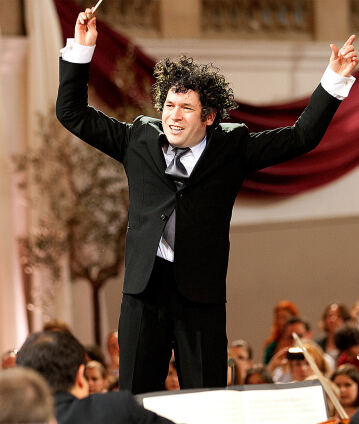Europakonzert 2012 from Vienna with Gustavo Dudamel and Gautier Capuçon

The Spanish Riding School in Vienna houses one of the world’s most unique institutions within a magnificent Baroque setting. The Berliner Philharmoniker gave their annual Europakonzert here in 2012 under the direction of Gustavo Dudamel – with music from Austria, of course. The main work was Beethoven’s revolutionary Fifth Symphony, while the brilliant soloist in Haydn’s First Cello Concerto was Gautier Capuçon, making his Philharmoniker debut.
Every year the Berliner Philharmoniker give a concert on 1 May to mark the anniversary of their foundation on 1 May 1882. It is held in a different cultural centre each year. In 2012 the orchestra celebrated its 130th birthday in a very special setting: the Winter Riding School of the Spanish Riding School in Vienna, which provided the magnificent Baroque backdrop to the orchestra’s twenty-second Europakonzert.
Between 1750 and 1755 Joseph Haydn studied in Vienna with Nicola Porpora, living only a short distance from the Spanish Riding School on the Michaelerplatz opposite the Hofburg. His First Cello Concerto in C major was written during the early 1760s in Eisenstadt, whither Haydn had moved in 1761 on entering the service of Prince Paul Anton Esterházy. Intended for the principal cellist in the court orchestra, it is now one of the standard works in the cello repertory and allowed its 2012 soloist, Gautier Capuçon, to display his phenomenal gifts to the full. The concert marked his debut with the orchestra.
Haydn’s technique of creating an entire work on the basis of the briefest of motifs is one that influenced later generations of composers, hence Brahms’s desire to raise a musical memorial to his predecessor in his St Anthony Variations op. 56a of 1873. In fact, the theme that Brahms used was not originally by Haydn but is that of an old pilgrims’ chant from Burgenland. Brahms, a native of Hamburg, could not have suspected this, of course.
But the main work on the programme was undoubtedly Beethoven’s irascibly revolutionary Fifth Symphony, whose concise, pounding four-note theme is said to represent fate, or so a much-quoted anecdote would have us believe. According to Die Presse, Gustavo Dudamel plunged into the opening Allegro con brio “with unbridled energy – it is hard to imagine a more breathless reading”. The musicians did not need to be asked twice and “set to with a will, quite literally to the last man – a far from self-evident act of self-abandon in the usual hurly-burly of today’s orchestral life,” in the words of Der Standard.
© 2012 EuroArts Music International
Categories
Artists
Our recommendations
- 2019 Europakonzert with Daniel Harding from the Musée d’Orsay, Paris
- The 1999 Europakonzert in Krakow with Bernard Haitink, Emanuel Ax and Christine Schäfer
- The 2009 Europakonzert in Naples with Riccardo Muti
- Simon Rattle conducts the 2016 Europakonzert in Røros
- The 1995 Europakonzert from Florence with Zubin Mehta and Sarah Chang
- 2007 Europakonzert from Berlin with Simon Rattle, Lisa Batiashvili and Truls Mørk